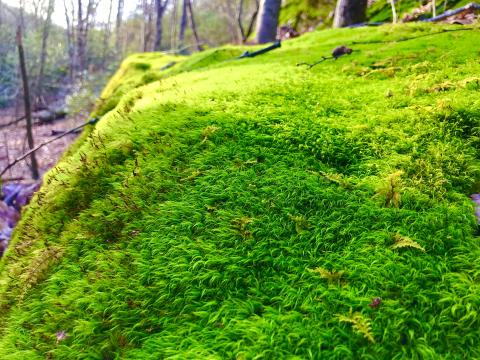Moss the Carpet of the Forest
By Steve Roark
Volunteer Cumberland Gap National Historical Park
Walking in the woods you are bound to rocks, soil, even the base of trees covered with a thick, green carpet. Moss may appear fairly plain, but it has a few features that call for more attention. It is an old and venerable life form unique to other plants you find in the forest.
The low, green moss common in our area is sometimes called cushion or carpet moss. It is one of the true mosses under a plant class called Musci. Moss is very different from other plants in that it has no true roots that take in water and nutrients from the soil. It has instead structures called "rhizoids" that only serve to anchor the moss in place. Water is absorbed throughout the plant surface, and it has the ability to store a good deal of it for dry times and for reproduction. Part of the life cycle of mosses is that reproductive cells (males) "swim" in water during rainy weather to join other cells (female), rather like the animal world.
A clump of moss is made up of a group of small individual plants, each made up of spongy stems covered with small, green, leaf-like structures that vary in shape by species. Moss has no true flowers but sends up a golden thread-like structure with a capsule on the end that releases spores to grow new moss plants.
Moss is most prolific in moist, shady locations and can make a place look like Fairy Land, but it can also be found on dry ridges and slopes. It prefers acidic soil and is used as an indicator of acidic soil. Seeing it in pasture fields means lime is badly needed. Since it doesn't need soil to obtain water or nutrients, moss often grows on solid rock where there is no competition with other plants. It is often the first plant to colonize exposed rocky areas and helps break down rock by the freezing of water retained by the plant and by the actions of secreted chemicals. On dead logs they delay water loss, speeding up the growth of decay organisms. Mosses also serve as cover for insects and provide building material for some bird's nests.
Moss is an ancient species, having been around far longer than flowering plants. Fossil records indicate they existed over two and one half million years ago. The next time you see some moss growing in the woods, maybe give it a closer look.
- Log in to post comments
